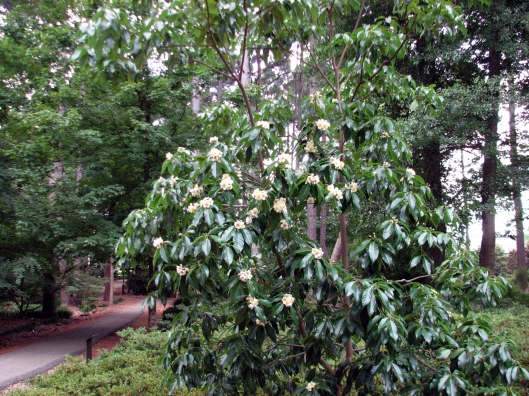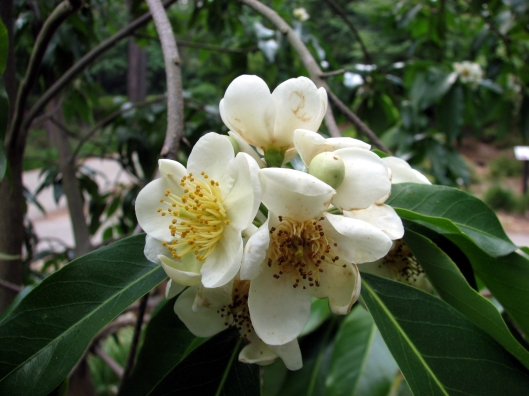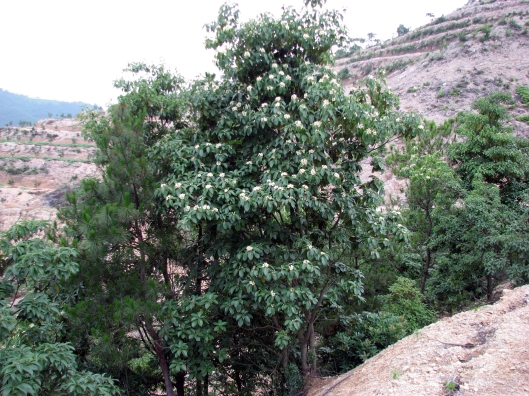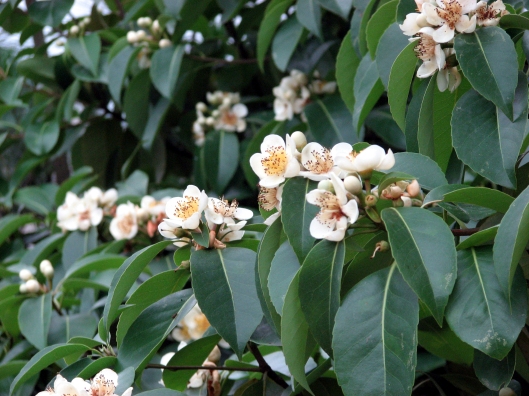Here’s another rarely encountered member of the Theaceae we like like. We’ve enjoyed Schima here and there in the Mast Arboretum and Ruby M. Mize Azalea Garden for many years. They’re attractive and durable small evergreen trees. Schima is a relative of Camellia. It’s a monotypic genus sporting dark-green bold elliptic leaves and a show of summertime white flowers. The genus has in the past been described with twenty species but there’s some lumping going on. Native from the eastern Himalayas of Nepal and eastern India across Indochina, southern China, Taiwan and to the Ryukyu Islands. While we have accessions that include S. argentea, S. wallichi, S. superba, and S. remoto-serrata, most botanists have begun to lump them all under S. wallichi. No one denies that there’s considerable variability in leaf size, tree form, and flowering. While it’s no doubt a nomenclature challenged genus, to our discriminating eyes, S. superba appears to have the largest glossier leaves of all.

Schima superba in the Ruby Mize Garden 06-24-2008

Schima superba in the Ruby Mize Garden 06-24-2008

Schima remotoserrata in the Ruby Mize Garden, June 24, 2005
While it can reach over 100’ in its home in S and SE China and parts south, Schima in our area might reach 20 to 40’ in that many years. That’s just a guess. On a recent trip to China, I was just plain lucky to catch the species in full bloom, June 17, 2007, on a mountain road near Linghai.

Near Linghai, China in Zhejiang Province June 17, 2007

Near Linghai, China in Zhejiang Province June 17, 2007
Linghai is about five hours South of Shanghai. It’s south of the city of Ningbo, a port city on the southern side of the mouth of the mighty Yangtze. Ningbo is the “Little Shanghai” with a bustling economy and businesses everywhere. Ninghai is south of Ningbo and part of the mountainous subtropical lands near the coast. The region normally enjoys good summer rains, but springs can bring extended dry spells. Some spots experience freezes and some do not with microclimates dominating here and there. In the mountains, the natural forest cover of the region depends, of course, on elevation, aspect, and how much human interaction is going on. In many areas, it’s a broad swath of factories, business, apartments, road and tunnel and rail projects, all quite land changing. There are other areas – wild lands, if you will, where the native vegetation has been given a chance. The diversity really is amazing. Loropetalum and Gardenias are weeds here! Cunninghammia, China fir, dominates the mid and upper slopes. Bamboo wants to own the place. In a wide variety of habitats, Schima seems to survive quite well in forest edges, bar ditches, roadsides, and fence rows. To me it looked like a durable plant in a tough landscape. The white flowers are axillary but mostly subterminal and the blooms feature a showy center of bright yellow anthers. Mildly fragrant, the flowers were caught just coming into full bloom in mid-June in central China, and, to my surprise, the same species was in full flower June 24th in our garden – that’s about the same time. I’m not sure how significant that is, but I liked the idea. Hardiness remains a question mark simply because we’ve tested our trees only into the mid-teens. We need some single digit events to get a better feel for adaptation in southern landscapes.
Our conclusion: This an interesting plant, one rarely encountered in southern gardens. It appears to have interesting horticultural potential across a wide band of the South. Dr. Tom Ranney of North Carolina State University has crossed Franklinia (also in the Theaceae) with Schima and Gordonia and they perform well in our garden. Schimilinias and Gordilinia! Gordonia X Schimas are a possibility? The big question is has anyone ever crossed Schima with Camellia? Some might ask why? But really, I bet everyone will want a Schimamellia, don’t you think? Just that name will sell it.
